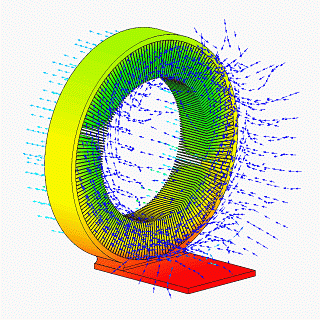
Picture credits: Heatlord at English Wikipedia, CC BY-SA 3.0, via Wikimedia Commons
Obstacles arising in the Engineering realm are never-ending. Considering these difficulties engineers and experts have raised their dependency on Computational Fluid Dynamics (or CFD). From designing a simple everyday commodity like an electric fan to a technically advanced supercar, Computational fluid dynamics has empowered engineers to confront strenuous engineering problems.
CFD being a ubiquitous, powerful, and economical tool, has surpassed conventional engineering methods for developing components that are optimized in performance, weight, and, at the same time, are cost-effective. In simpler words, CFD has expedited the process of solving complex engineering problems.
Notably, the rise in the constant advancement of components and machines has plummeted an engineer’s dependency on solving problems through conventional ways. For instance, without CFD designing a simple component would require extensive hand calculations and multiple design alterations, but with computational fluid dynamics, this process has become fairly fast and simple.
What is CFD, and how does it work?
CFD or Computational Fluid Dynamics is a branch of Computer-Aided Engineering (or CAE) and is based on the Navier-Stokes equations and its underlying principles. CFD deals with fluid flow and heat transfer problems. As a result, it assists CFD consulting services providers/ engineers in improvising and designing complicated parts and pieces of machinery by mimicking the exact working conditions.
The following three phases combine to a complete CFD analysis:
- Pre-processing
In this initial stage, the problem statement is broken down. Type of fluid flow, whether viscous or inviscid, compressible or incompressible, and steady or unsteady, is specified along with the initial-boundary conditions. As CFD employs the technique Finite Element Method, the component is discretized into innumerable smaller elements as a part of the process.
- Solving
Through utilizing numerical equations, the solver performs the actual computation to deduce the outcome as per the specified conditions.
- Post-processing
Finally, the contrived results are examined by experts. Conclusions are drawn by investigating the graphs and other simulated static, dynamic images.
How is Computational Fluid Dynamics Useful?
There are innumerable instances in the engineering sector where CFD is employed to find a cost-effective and desirable solution. Moreover, with incessant advancements, experts’ dependability on CFD has risen and is only going to increase in the coming years.
In addition, to allowing experts to overcome the setbacks, CFD empowers engineers and designers to:
- Minimize Cavitation
Cavitation is the formation of bubbles of vapor within a liquid. This happens when the local static pressure drops below the vapor pressure due to the flow dynamics. Though these bubbles are ephemeral, they can lead to structural wear, noise, vibration, and may impede the performance of the component.
Cavitation can hamper the working of products like:
- Water and fuel Pumps
- Fuel Injectors
- Valves & Compressors
- Turbochargers in Engines
- Marine pieces of equipment and Propellers
Due to Cavitation’s nature, it is almost impossible to identify this phenomenon using physical and manual testing. Thus, it becomes crucial to detect Cavitation at an early stage in the product designing process. Mechanical design firms specializing in computational fluid dynamics can help optimize the products’ design to counter Cavitation using CFD.
2. Reduce Turbulence
Turbulent fluid flow can cause damage to internal linings and the structure of pipes and hoses. Thus, it becomes crucial to design a component in a way that does not obstruct the flow of fluid. In most conditions, a laminar flow is preferred as it curtails unnecessary losses. CFD helps designers to analyze the flow by simulating the fluid flow pattern following the constraints.
3. Optimize fluid interaction with structures
One of the prominent applications of CFD is the multiphysics study of the interaction of structures with fluid. The fluid may exert some definite pressure on the solid structure due to the motion or the thermal properties. These forces may result in the structure’s deformation and alter the fluid natural flow tendency. Therefore it is vital to study the effect of fluid on the interacting surfaces to ensure safety, durability, and reliability. Optimizing the fluid-structure interaction becomes crucial by performing detailed analysis to warrant proper working of the structure.
4. Enhance Thermal response
Controlling and optimizing temperature is highly crucial for the efficient working of components. This also ensures the safety, reliability, and longevity of the part. Simulation of CFD projects by established mechanical design firms can detect the causes of thermal problems at a rapid pace. CFD allows experts to simulate various designs under the intended operating conditions to find and optimize the most functional design.
5. Improve Aerodynamics
Aerodynamics deals with fluid interaction, namely; air with a solid body, whether at rest or in motion. Whether designing an automobile or an aircraft, optimizing the airflow around the object is important. With CFD, experts can improve the design by identifying design barriers in the existing design. Furthermore, optimizing a component for better aerodynamics could be profitable by consulting mechanical design firms for the CFD consulting services.
Besides, the listed reasons for how CFD solves the challenges faced in the engineering sector. There are a plethora of other applications of computational fluid dynamics in product development and optimization.
Conclusion
To conclude, Originating from mankind’s efforts to understand the extensive power of natural elements such as winds, heat, and waves, Computational Fluid Dynamics offers a solution to the inevitable problems faced by engineers and designers.
Playing a key role in the evolution and development of new products and components, experts with the ability to extract the high efficacy of computation fluid dynamics can save resources such as time, money, and manpower. Thus, seeking CFD consulting services offered by renowned agencies and mechanical design firms could Fastrack the CFD projects in hand.
